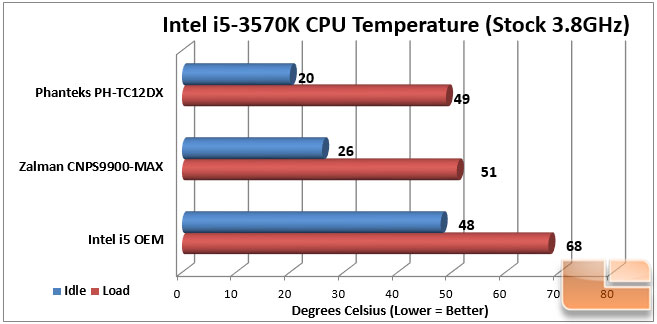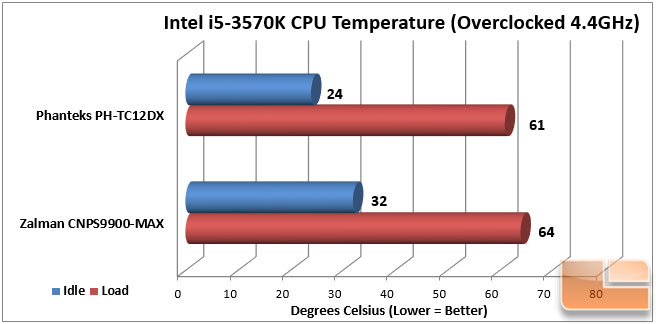Phanteks PH-TC12DX CPU Cooler Review
Test System and Temperature Testing
As previously mentioned, the Phanteks PH-TC12DX CPU cooler will be tested on an Intel based system.
| Make / Model | |
| CPU | Intel i5-3570K |
| Memory | Kingston KHX1866C9D3K4/16GX |
| Motherboard | Gigabyte GA-Z77X-UP5-TH |
| Video Card | Gigabyte HD 7870 |
| Hard Drives | Intel 520 180GB |
| OCZ Vertex 4 | |
| Seagate 2TB | |
| Power Supply | Lepa G-Series 650W |
| Chassis | Bitfenix Raider |
| Operating System | Windows 8.1 RTM |
| Ambient Temperature | 19.5C |
In addition the test system components, the TC12DX will be tested against two other coolers.
| CPU Coolers tested |
| Intel i5 OEM CPU Cooler |
| Zalman CNPS9900-MAX |
Today, I will be using CPUID HWMonitor 1.21 to monitor all temperatures. Idle temperatures were achieved by leaving the computer idle on the desktop with no applications running for 30 minutes. Load temperatures were recorded while running Prime95 v.25.11 on the “Blend” Torture Test. Each test was run 3 times with the average of the four cores recorded. Arctic Silver 5 was used for the thermal paste on all three coolers.

It should not come as a surprise to anybody that the Phanteks was able to outperform the stock Intel cooler. What was surprising was the thermal differences between the Phanteks PH-TC12DX and the Zalman CNPS9900-MAX. While the Phanteks was 6 degrees Celsius cooler than the Zalman cooler at idle, once things heated up, there was only a 2 degree Celsius difference between the two coolers, with the TC12DX still taking the lead.

A cooler like the Phanteks PH-TC12DX should be able to cool the processor enough to allow overclocking. The i5 3570K is unlocked so it can be overclocked. With the Zalman CNPS9900-MAX, I was able to take it up to 4.4GHz at 1.5V. However, with the Phanteks PH-TC12DX a little extra overclock was possible to 4.6GHz. While the max overclock on the Zalman was lower than the Phanteks, overclocking was kept at 4.4GHz to keep things on the same level. Once again, the Phanteks cooler outperformed the Zalman. At idle, the difference was 8 degrees Celsius, while at load the difference was smaller, at 3 degrees Celsius.
During the load testing, I made note of the volume difference in the various fans. Obviously, the loudest was the Intel OEM cooler; the Zalman CNPS9900-MAX was a little louder than the other components in the test system. However, the PH-TC12DX cooler, both fans were indistinguishable from the other components in my system at any level.
